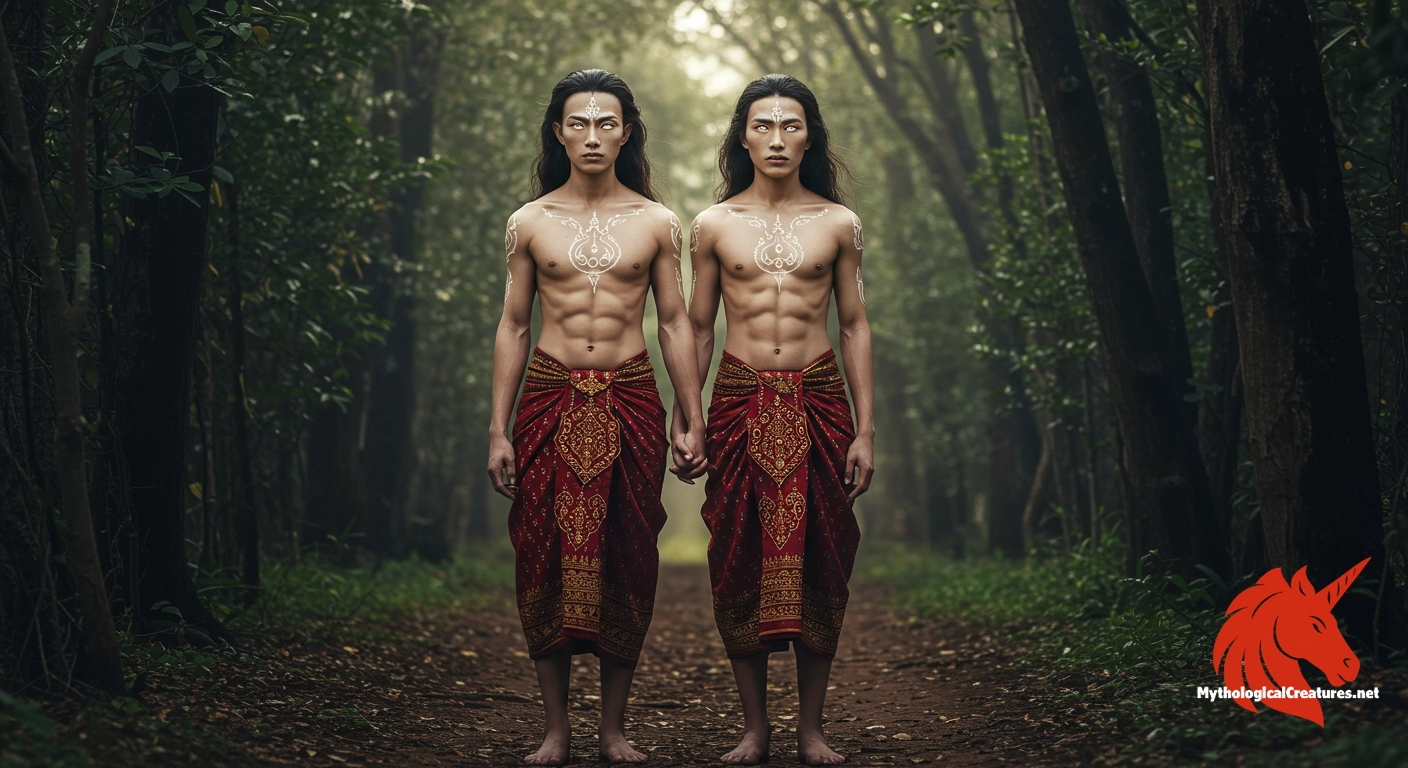Pyelepyin Maunghnama: Pyelepyin Maunghnama are a revered pair of traditional Burmese nats known as the Pyelepyin siblings.

Pyelepyin Maunghnama
Pyelepyin Maunghnama - They exemplify the role of familial bonds in the supernatural realm and are central to the cultural practices of Burmese nat worship.
Origins & First Encounters
Pyelepyin Maunghnama are a pair of profound and enigmatic figures within the Burmese nat tradition, embodying a timeless duality through their roles as both guardians and arbiters of fate. Their presence in Burmese spiritual lore is marked by an air of mystique and reverence, with their origins interwoven with ancient animistic practices predating the country’s Buddhist traditions. Emerging from a rich tapestry of local folklore, these sibling nats, known respectively as Saw Pha Thar and Saw Mya Thar, have long been regarded as embodiments of both benevolence and stern vigilance. They are celebrated in rural and urban settings alike, often invoked to ensure communal balance and harmony. The siblings are seen as representatives of the natural world and the moral universe, linking the human experience to the fleeting boundaries between life, death, and the supernatural. Their early attestations can be found in oral narratives and ritual performances that have been passed down through generations. With each retelling, their legend has absorbed local nuances and cultural variations, reflecting the evolving nature of Burmese belief systems. Their persistent presence in festival rites and artistic representations underscores their role as central figures in the vibrant spiritual life of Myanmar.
Source Texts & Tale Variants
The accounts of Pyelepyin Maunghnama are predominantly rooted in the oral traditions and ritual practices of Burmese communities. Over time, their legends have been preserved in traditional performance arts, including dance dramas and ceremonial recitations, which provide vivid portrayals of their mythic deeds. While not extensively recorded in classical texts, the siblings have prominently featured in folktales that circulated among village elders and local storytellers. Traditional palm-leaf manuscripts and local ritual documents offer glimpses into their origin stories and the symbolic lessons attached to their character. The narrative variations that have emerged across different regions of Burma reveal a dynamic tradition where the two nats are portrayed with subtle differences reflecting local values. Some versions highlight their protective aspects during times of calamity, while others emphasise their role in maintaining the balance between prosperity and misfortune. Informal records recorded by community custodians show that their myth has been a fluid and evolving narrative, adapting to the changing cultural landscape. The enduring nature of these stories is a testament to the strong communal bonds that encourage the sharing and reinterpretation of these ancient legends.
Form & Powers
The physical depictions of Saw Pha Thar and Saw Mya Thar are as striking as the narratives that surround them. Both figures are rendered with an ethereal quality that hints at their otherworldly origin, blending vivid realism with a touch of mysticism. Saw Pha Thar is often illustrated with a commanding presence, his face marked by penetrating eyes and a countenance that reflects both wisdom and latent martial strength. In contrast, Saw Mya Thar is typically portrayed with gentle, graceful features, her expressions conveying emotional depth as well as a quiet, resolute power. Their traditional attire is rich with intricate patterns and vibrant colours that symbolise their connection to nature and ancient Burmese artistry. Detailed headpieces and ornamental jewellery frequently enhance their divine images, each element meticulously crafted to reflect layers of symbolic meaning. The artistry used in these depictions encompasses a range of media from temple engravings to contemporary paintings, ensuring that the legacy of their form remains both flexible and enduring. Variations in size and posture across different artworks further highlight the creative licence afforded by storytellers to capture their essence in diverse and culturally resonant ways.
Regional Faces
The interpretation of Pyelepyin Maunghnama varies considerably across different regions of Myanmar, with local customs colouring their narrative and visual representations. In some highland areas, the siblings are revered as forest guardians, where legends imbue them with the power to control seasonal changes and natural phenomena. Along the river valleys, rituals dedicated to these nats are intricately linked to the cycles of water and fertility, reflecting deep-rooted agrarian values. Urban depictions often lean towards a more refined and symbolic portrayal, merging traditional iconography with modern artistic expressions. In regions with a strong animist heritage, the siblings are sometimes depicted as avatars of natural forces that both nurture and discipline in equal measure. Communities in the central parts of Myanmar may celebrate distinct festivals in their honour that incorporate unique music, dance, and ceremonial dress differing from rural interpretations. These regional variations not only demonstrate the flexibility of myth but also underscore the importance of local identity in the shaping of broader cultural narratives. The adaptive nature of their story serves as an excellent example of how regional and local influences continually enrich Burmese folklore.
Cultural Parallels
Pyelepyin Maunghnama share notable parallels with sibling deities and guardian spirits found in other parts of Asia, reflecting a universal motif of duality in mythological constructs. Much like the twin figures in various Eastern traditions, they symbolise the balance between protection and retribution, mirroring the inherent contradictions of nature and society. This duality finds resonance with similar mythic pairs in Chinese and Indian lore where dual gods often govern the delicate equilibrium of the cosmos. Their role as both nurturers and potential harbingers of calamity is reminiscent of the broader cultural themes where divine beings are entrusted with both order and disruption. In many ways, their narrative encapsulates the philosophical idea that balance is maintained through the interplay of opposing forces, a concept widely echoed in the symbolism of yin and yang. The comparative study of these figures highlights the common human desire to understand life through the interplay of light and darkness. While each cultural tradition casts these twins in a uniquely local light, the underlying universal themes serve to connect them across geographical boundaries. This analysis not only deepens our understanding of Pyelepyin Maunghnama but also situates their story within a global framework of mythic archetypes and dualistic symbolism.
Legacy & Modern Evolution
The historical evolution of Pyelepyin Maunghnama showcases a fascinating journey from ancient animistic rituals to modern cultural symbolisms. In early Burmese society, these nats were central figures in spiritual ceremonies, where their stories were recounted during community gatherings and seasonal festivals. Over the centuries, as Buddhist influences grew stronger, the depiction of these siblings adapted in order to harmonise with both indigenous and imported spiritual frameworks. Their iconography has transformed significantly, with contemporary representations now seen in modern art forms, theatrical performances, and even literature. This evolution reflects the dynamic nature of myth, where traditional beliefs are continually reinterpreted to address the concerns and sensibilities of new generations. In popular culture, they are sometimes symbolised as the eternal struggle between modernity and tradition, bridging the gap between age-old rituals and present-day artistic expression. The resilience of their myth is evident in the persistent reverence they enjoy among both rural believers and urban enthusiasts. Their enduring legacy not only speaks to their historical importance but also acts as a vibrant reminder of the rich cultural heritage that continues to shape Burmese identity.
Interesting Fact
The name Pyelepyin literally translates to 'siblings', reflecting the unique duality and interdependent nature of these revered spirits in Burmese nat worship.
Quick Creature Info
Origin:
Our Mythic Legendary Rating:

Also Sometimes Known As:
Supernatural Powers:
Physical Attributes:
Abilities:
Behavior:
Lore:
Related Creatures, Tales or Lore
- TThagyamin
- MMin Mahagiri Nat
- KKami
References
Discover Another Mythical Legend You May Not Have Heard Of?
Uncover the mysteries of ancient folklore and expand your knowledge of legendary beings from cultures around the world.
Dare to Meet the Sucellus....
Mythical Disclaimer: The images and data on this site are derived from various historical and literary sources, but we have found that many myths often have multiple versions and interpretations across references, sometimes contradictory. As a result, these creature depictions are artistic interpretations—imaginative blends of folklore, legend, and a dash of AI guesswork. Because creature descriptions vary widely, our illustrations and accompanying information represent our best effort to honor mythology while bridging creative gaps. Enjoy these interpretations—just remember, we've done our best to respect the stories and validate available data, but in the realm of mythology, details often shift, imagination leads the way, and nothing is ever set in stone!
Curated by the Mythological Creatures Team (rev. May 2025)
